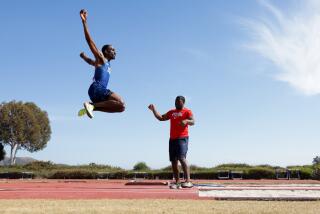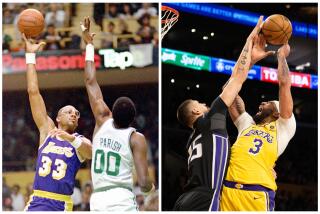Fine Tuning Visual Skills Helps Athletes in All Sports
PORTLAND, Ore. — The difference between a hit and a strike in professional baseball could be the width of a batter’s nose, something it took a football player-turned-eye doctor to discover.
Alan Reichow played football for Montana State before he became an optometrist. Now he is president of the American Optometric Assn. and one of the leaders in the field of sports vision science.
Reichow and colleague Brad Coffey say they have compiled the largest database in the nation that catalogs the visual skills of professional and Olympic-level athletes.
Their work is part of an increasingly important training program for elite athletes that was largely ignored when Reichow was playing college ball in the 1970s.
“I think it was just a lack of awareness,” Reichow said. “Everybody got a physical to make sure a team was in top condition, but nobody ever checked their eyes. People just didn’t recognize the problem existed.”
During his optometric studies, Reichow first began to notice that some athletes had trouble focusing or tracking objects even though their vision was 20-20, or better.
Reichow and Coffey help top athletes fine tune their visual skills, whether it’s batting or catching a long bomb. They also help improve hand-eye coordination and timing, often with dramatic results.
“The bridge of the nose can actually block one eye, causing the brain to suppress the image from the other eye in some batters,” Reichow said.
“We were studying one major league team and we predicted exactly what would happen with one batter, that he’d be late to the left. The guy stepped up to the plate and sure enough, he was late to the left. The general manager couldn’t believe it.”
One of Reichow’s success stories is Jake Reed, a Grambling State receiver picked by the Minnesota Vikings in the third round of the 1991 NFL draft.
Reed was sent to Reichow and Coffey at the Pacific University Family Vision Center in Portland after he began missing catches in the pros that he handled with ease in college.
A battery of tests showed that Reed simply lost the ability to track the ball when it got close to him, a problem that was also causing severe headaches during reading.
“He had clarity but no tracking system,” Reichow said. “Looking ahead he was OK. But left or right, and he lost it. It was a serious problem. He was even having trouble reading the playbooks.”
After undergoing a series of visual exercises designed by Reichow and Coffey, Reed began snatching just about every pass thrown his way, his former Vikings coach said.
“He had gotten to the point to where he didn’t know when the ball was going to get to him,” said Tom Moore, now an assistant coach at Detroit. “Alan had to do a series of tests to get him to focus on fluid movement so his eyes would focus on things as it approached him. I saw the results. It was incredible.”
Moore, a veteran college and pro coach, said he was impressed by the ability of Reichow and Coffey to predict Reed’s problems on the field simply by performing their tests in their office.
“We sent Jake out there without him ever having seen Jake at a practice, and they gave Jake a test and it showed what kind of problems Jake would have as a receiver,” Moore said, “and it was like they’d been to every practice Jake had been in.”
Coffey said the sports vision specialty has been developing since the mid-1970s. He and Reichow earned a reputation in the field after developing one of the first formal assessment programs at Pacific University in Forest Grove.
“We were approached by the U.S. Olympic Committee in the 1980s to standardize testing, so we developed a standardized assessment battery that has been adopted in the U.S., Canada and parts of Europe,” Coffey said.
Many of the tests appear simple, such as reacting to rows or patterns of flashing lights, tracking balls tethered on strings, or recognizing strings of random numbers flashed on a screen.
But Coffey and another pioneer in the sports vision field, William Harrison, an optometrist in Laguna Beach, say the exercises have a measurable effect on the intricate link between the eyes, brain and hands.
Harrison, who works mostly with major league baseball teams, also has worked since 1971 with pro football players, golfers, tennis and water polo players--just about every kind of athlete who wants an edge.
His patient list includes former Los Angeles Rams linebacker Mel Owens, Chris Duplanti of the U.S Olympic water polo team, golfer Billy Casper and Brady Anderson of the Baltimore Orioles.
Anderson, left fielder and leadoff hitter for Baltimore, improved his batting average and home run total after working with Harrison, who is modest about his role.
“I start out with the simple perspective that every athlete in the world wants the best equipment,” Harrison said, “ranging from skis to boots to bats. But they also want the best physiology they can get, and vision is a crucial part of sports physiology.
“I point them in the right direction, and they do the rest.”
More to Read
Go beyond the scoreboard
Get the latest on L.A.'s teams in the daily Sports Report newsletter.
You may occasionally receive promotional content from the Los Angeles Times.










